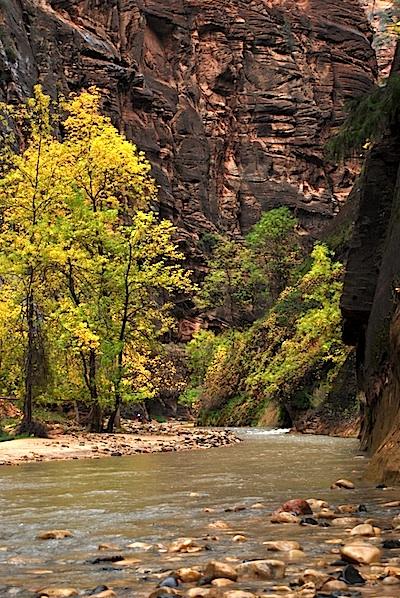
A management plan for the Virgin River and its tributaries in Zion National Park has been completed. Kurt Repanshek photo.
Zion National Park has completed a plan to guide management actions and visitor use on the Virgin River and its tributaries.
The plan was necessary as sections of the river in 2009 were added to the National Wild and Scenic River System. The Wild and Scenic River designation includes segments of the Virgin River, La Verkin Creek, Taylor Creek, and North Creek (including some tributaries) in Zion National Park and adjacent Bureau of Land Management wilderness.
The completed plan will provide a framework to guide future resource management and visitor use.
The plan provides protection for 144 miles of designated wild and scenic rivers within Zion National Park. The management and monitoring strategies found in the plan are designed to protect and enhance the rivers' free-flowing condition, water quality, and other values that qualify these river segments for inclusion in the National Wild and Scenic River System.
The management plan identifies:
* The kinds and amounts of visitor use that each river segment can accommodate while ensuring protection of river values;
* The types and levels of development allowed in each river corridor;
* Indicators that will be monitored to track changes caused by human activity;
* Adaptive management strategies to implement as changes occur;
* Actions to preserve the rivers free flowing condition; and
* Actions to protect and enhance water quality, ecological processes, scenic values, recreational opportunities, and fish and wildlife.
To read the details of the management plan, go to this page.

 Support Essential Coverage of Essential Places
Support Essential Coverage of Essential Places







Comments
Could someone explain why we prefer the Virgin Spinedace over the Rainbow Trout in what looks like could be excellent fishing waters?
Rainbow trout aren't native to this fishery. The Spinedace is.
This from the park's website:
So?
Soooo, in national parks they actually try to preserve the native species over the non-native species....but you know that.
I will ask the question again. Why? There are billions of species that have naturally (and in some cases unnaturally) disappeared from this earth. Nobody misses them. Who, other than a few ichthyologist, would miss the Spinedace. I know many a fisherman that would like to see the Rainbow Trout.
"nobody misses them"
interesting comment...Let me guess, you subscribe to the biblical notion that it is man's duty to subdue the earth and craft it towards man's own needs...
EC- I appears as though you have failed to realize that all parts of an ecosystem are interconnected. This is the reason we are working hard to save the delta smelt in northern California. But giving it a second thought, I actually dont know why I am engaging you in conversation... Let me know when you start to believe in modern science...
Rambler I subscribe to the notion that the earth will do what it will do and in the grand scheme of things, man will craft nothing - intentionally or unintentionally.
BTW I am unaware of biblical notion you refer to. Can you document that?